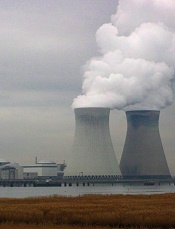
Photo by Rafaël Delaedt
Living near a certain type of nuclear facility may increase a child’s risk of developing acute leukemia, a new study suggests.
The research showed a 2- to 3-fold increased risk of acute leukemia among children living near 1 nuclear facility in Belgium—Mol-Dessel.
However, children who lived near the 3 other Belgian nuclear facilities studied—Doel, Fleurus, and Tihange—had no such increased risk.
Researchers said this study does not confirm a causal relationship between the Mol-Dessel facility and the increased risk of leukemia observed.
However, they did say the facility seems a plausible cause of the increased risk because the data showed significant associations between acute leukemia incidence and 3 surrogate measures of exposure—distance from the facility, prevailing winds, and simulated discharges of the radionuclide Ar-41.
An Van Nieuwenhuyse, MD, PhD, of the Scientific Institute of Public Health in Brussels, Belgium, and colleagues conducted this research and reported the results in the European Journal of Cancer Prevention.
Facilities
The study included 4 nuclear facilities in Belgium—Doel, Mol-Dessel, Fleurus, and Tihange. (The researchers also evaluated a fifth facility, Chooz, but they said it was not possible to draw conclusions regarding this site because the region around it is sparsely populated, which limits the number of cancer cases.)
Doel and Tihange are electricity-generating nuclear power plants that started up in 1975. The nuclear facility at Fleurus has produced radionuclides for medicine and industry since 1971.
The Mol-Dessel facility started up in 1956, and a combination of nuclear activities have taken place there, including scientific and technological research, applied research and metrology, operational waste management, the Belgian Underground Research Laboratory, and the production of fuel assemblies for pressurized-water reactors based on uranium oxide and mixed oxides.
Analysis
The researchers set out to determine whether there was an excess incidence of acute leukemia among children ages 0 to 14 who lived in the vicinity of the aforementioned nuclear facilities. The team analyzed data spanning the period from 2002 to 2008.
For all 4 facilities, the researchers used 2 different measures of surrogate exposure to radionuclide gaseous discharges—residential proximity to the nuclear site and prevailing wind directions.
For the Mol-Dessel site, the researchers also used estimated discharges of the radionuclide Ar-41 as a surrogate measure of exposure.
Results
The data did not show an increased incidence of acute leukemia among children living near the Doel, Tihange, or Fleurus facilities. However, children living within 15 km of the Mol-Dessel site had a significantly increased risk of acute leukemia.
In fact, the researchers said they observed statistically significant associations as a function of distance, prevailing winds, and simulated Ar-41 discharges, which suggests a potential link between acute leukemia incidence and the Mol-Dessel site.
The rate ratios for the Mol-Dessel facility, which were adjusted for age, sex, and socioeconomic status, were:
- 2.70 (95% CI: 1.15–6.33) for children living 0 to 5 km from the site (5 cases of acute leukemia)
- 1.82 (95% CI: 1.02–3.25) for children living 0 to 10 km from the site (11 cases of acute leukemia)
- 1.96 (95% CI: 1.19–3.22) for children living 0 to 15 km from the site (15 cases of acute leukemia)
- 1.09 (95% CI: 0.71–1.61) for children living 0 to 20 km from the site (21 cases of acute leukemia).
The 3 communities lying in the dominant wind direction of the Mol-Dessel nuclear site had rate ratios of 6.81 (95% CI: 2.28–20.32), 4.39 (95% CI: 1.46–13.17), and 3.74 (95% CI: 0.98–14.27).
The researchers calculated P values using Stone’s test, Bithell’s linear risk score test (LRS), and Bithell’s linear risk score test with corresponding ranks as a function of the different measures of surrogate exposure (LRSr).
All 3 tests showed a significant association between acute leukemia incidence and proximity to the Mol-Dessel site (P<0.01 for all). However, only LRS and LRSr showed a significant association for wind direction (P=0.01 and 0.03, respectively) and simulated radioactive discharges by Ar-41 (P<0.01 for both).
The researchers noted that, although these results suggest an association between acute childhood leukemia and the Mol-Dessel site, this study had limitations, and more research is needed.


